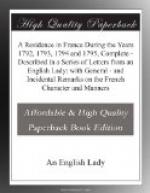By requiring no more implements than about five shillings will purchase, a lacemaker is not dependent on the shopkeeper, nor the head of a manufactory. All who choose to work have it in their own power, and can dispose of the produce of their labour, without being at the mercy of an avaricious employer; for though a tolerable good workwoman can gain a decent livelihood by selling to the shops, yet the profit of the retailer is so great, that if he rejected a piece of lace, or refused to give a reasonable price for it, a certain sale would be found with the individual consumer: and it is a proof of the independence of this employ, that no one will at present dispose of their work for paper, and it still continues to be paid for in money. Another argument in favour of encouraging lace-making is, that it cannot be usurped by men: you may have men-milliners, men-mantuamakers, and even ladies’ valets, but you cannot well fashion the clumsy and inflexible fingers of man to lace-making. We import great quantities of lace from this country, yet I imagine we might, by attention, be enabled to supply other countries, instead of purchasing abroad ourselves. The art of spinning is daily improving in England; and if thread sufficiently fine can be manufactured, there is no reason why we should not equal our neighbours in the beauty of this article. The hands of English women are more delicate than those of the French; and our climate is much the same as that of Brussels, Arras, Lisle, &c. where the finest lace is made.
The population of Arras is estimated at about twenty-five thousand souls, though many people tell me it is greater. It has, however, been lately much thinned by emigration, suppression of convents, and the decline of trade, occasioned by the absence of so many rich inhabitants.—The Jacobins are here become very formidable: they have taken possession of a church for their meetings, and, from being the ridicule, are become the terror of all moderate people.




